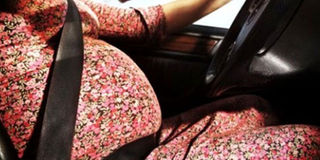Driving when pregnant; making it comfortable

Wearing a seatbelt protects you and your unborn baby from injury or death in the event of a car crash, according to Joseph Nsengiyumva a gynaecologist at Bethany Women’s Hospital in Luzira.
“Many women worry that wearing a seat belt during pregnancy may injure their unborn child but there is no proof that it actually injures the foetus. As a matter of fact, a mother and the unborn child are safer with the seatbelt worn in case of an accident,” adds the gynaecologist.
From the Ugandan and UK highway code, anyone who sits behind the wheels must wear a seatbelt even if she is expecting. This is for the safety of the mother and the baby in case of an accident, warns Chris Muwanguzi, an instructor at International driving agency.
According to Muwanguzi, “The law states that you must wear a seat belt unless you qualify for a medical exemption and have the certificate to prove it. If this is the case, your doctor will issue a medical exemption certificate which you must show if stopped by the police while driving.”
How to sit in a car while you are pregnant
According to Ben Lubowa, an instructor at Uganda Driving Standards Agency, other than the common problems associated with pregnancy, driving while pregnant is safe and it is safer to wear a seatbelt than not to.
However, as the pregnancy progresses, it becomes more difficult for you to enter and exit a car especially with the steering wheel blocking your way.
“Although there is no rule on when pregnant women should stop driving, Lubowa says most women tend to stop driving at seven months because they are never sure what may happen. I think the next two months become more uncomfortable too.”
Position yourself correctly in the car and move your seat as far back as your legs will allow you or is comfortable. Then tilt your seat slightly away from the steering wheel and make sure that the steering wheel is tilted toward your breastbone rather than toward your abdomen.
On long journeys you may be required to stop more often for toilet breaks or stretch to relieve any backache and prevent swelling of the feet.
“It is advisable to take breaks like after every 90 minutes so you can stretch. This will help to keep proper circulation of blood, particularly in your legs,” says Nsengiyumva.
When you wear your seatbelt, avoid the tummy area by wearing it in such a way that the shoulder strap is positioned off to the side of the uterus and goes down between the breasts.
“It is advisable for pregnant women to wear a 3-point lap and diagonal seat belt.
These belts are designed to stop you from being thrown from the car during an accident. The shoulder strap helps keep your body weight off your tummy and therefore off your unborn baby in the event of an accident. The belt is worn past the shoulder, between the breast and avoiding the tummy,” says Nsengiymva.
He adds, “The lap to belt portion of the seatbelt must be placed well under the tummy, tightly fitting over your pelvis and pubic bone and across your hips as high up on your thighs as possible.
It is important to constantly check while driving to see if the lap belt has not risen up on to your tummy.” Nsengiymva also recommends maternity seatbelts for pregnant women to ensure safety without damaging the unborn baby.
Such a seatbelt is made so that it holds you down without exerting any pressure on your abdomen. Rather than go across the lower tummy, it holds you down at the thighs.
Your comfort during pregnancy
We never recommend mothers to sleep on their back especially after six months. Even if you do not tell the mother, she would start feeling uncomfortable because the uterus compresses the inferior vennacava (a vessel that carries blood from the lower parts of the body to the heart) the heart will not be able to receive blood so a mother will develop postural hypotension where she will feel like fainting and running out of breath. We advise them to keep changing on the sides.
Avoid impact exercises (those that can cause effect to your back or abdomen) like running, jumping, frog jumping, over bending, lifting heavy objects, sporting exercises. You can go for walking, brisk walking, hiking, and swimming but avoid diving and sex as long as the mother is comfortable with it.




